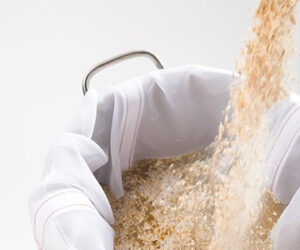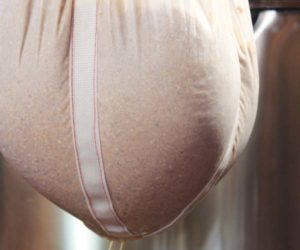Lowdown on Lautering: Tips from the Pros
Lowdown on Lautering
There’s nothing like formulating a recipe, crushing the grain and hitting all the temperatures during the mash, only to be thwarted by problems when you’re draining the sweet wort off the mash. Lautering can be a frustrating part of the brewing process.
The term “lauter,” a German word for clarify, refers to all of the steps involved with separating the sweet wort from the spent grains after your mash. Ideally, your mash tun is equipped with a straining device and can double as a lauter tun. If there is no straining device in your mash tun, you need to transfer your mash to a lauter tun.
During lautering, the wort is strained off and recirculated back through the grains until it begins to run clear. This process is referred to as “vorlauf.” The vorlauf clarifies the wort by filtering out unwanted husks, protein and other debris.
Next, it’s time for sparging. As you drain the wort, you add sparge water at approximately 176° F. The water is added gradually to match the rate of the outflowing wort. The sparge water flows through the grains, extracting fermentable sugars as it goes. After this second and final collection of wort, your lautering job is done.
Homebrewers often face challenges when it comes to lautering so we asked some pros for advice.
——————————–
Brewer: Rick Sanseverino is a brewer at the Valley Forge Brewing Company in Wayne, Pennsylvania. Rick attended the Siebel Institute in Chicago.
The first and most important key to effective lautering is to make sure you keep the grain bed covered with liquid. When the grain bed is uncovered, air gets entrained in the grain bed and dramatically slows the flow of sparge water through the bed.
Next, you need to get the right rate of flow. Too slow will cause a loose grain bed; floating particles will get sucked into your wort and transferred over to your boil. Too slow is anything below a moderate, unbroken flow of wort. If it trickles, the grain bed is probably compacted. Too fast can cause the bed to compact or collapse and can create crevasses in the grain. The right speed is a clear unbroken stream of wort that flows straight down. Be conscious of how much water you are using so that the grain bed doesn’t get too loose.
Set the grain bed before you start lautering by raising the temperature to about 168° F. Then examine the quality of the wort as you recirculate it through the grains for a while. As the grain bed settles, it will act as a natural filter, which will help clear the wort. You want nice clarity before you start transferring over to boil.
Take gravity readings as you lauter. It should be high at first, reflecting high sugar content, then will drop as you add sparge water. check the gravity again when you have collected about 2 gallons. It will have dropped significantly. When you get to the end, you’ll be looking at an end gravity of between 2 to 5 degrees Plato (where 1.004 is roughly equivalent to 1 degree Plato), depending on the style of beer.”
————————-
Brewer: Jon Graber has been a brewer at Mt. Hood Brewing Company in Government Camp, Oregon since 1995. He did a brewing apprenticeship with Dave Logsdon of Wyeast Labs.
We approach lautering with several thoughts in mind. Too hot or too long are two common lautering mistakes. We don’t want to sparge too hot. The goal is to avoid too many tannins in the beer, and hot water (above 176° F) will extract those qualities. It also deactivates the enzymes in the grain and stops the conversion of starches to sugars, fixing the carbohydrate spectrum of the wort.
Don’t lauter and sparge for too long or you risk over-extracting your beer. The final runnings will be full of haze and solids, which will be detrimental to your beer. The best way to avoid this is to not use too much water.
Make sure the grist is properly milled. I prefer it to be just barely cracked, with the husks intact and no dust. This isn’t easy for the homebrewer but, to get this right, constantly check your mill setting.
Finally, make adjustments to your pH. Many brewers treat their brewing water, but don’t consider the quality of their sparge water. Sparge water quality should be consistent with your brewing water.
——————————–
Brewer: Juergen Knoeller joined Bayern Brewing Company in Missoula, Montana in 1987 as the brewmaster. In 1990 he became the brewery’s owner. He has a Master’s in Brewing from Doemens in Germany.
It’s important to get a quality sparge, and there are many ways you can do this. First, the amount of water you use to sparge should be about the same that you use during the mash. If you use four gallons during the mash, you’ll circulate this amount during lautering to clear up the wort, then add four more gallons of sparge water to draw off the excess sugars from the grains.
It’s important to recirculate the wort long enough so that it doesn’t have particles in it. You will run into fermentation problems if you have solids in the wort, since this will slime up your yeast cell surfaces and prevent them from actively fermenting. You hear from lots of homebrewers that they have a perfect brewing system but if they don’t lauter correctly, they’ll end up complaining that it took three weeks to get an active fermentation. This is because they didn’t circulate out enough of the solids.
Ten minutes of recirculation is fine (but you should measure your success by the clarity of the wort). Just remember that brewing is a constant cleaning process, and that lautering is essentially cleaning your wort. You want clarity before you pump it over for the boil.
Also, be sure you don’t run the grain bed dry. This will start to oxidize the wort, which will lead to tannic flavors in your beer. Always keep about 1/2 inch of liquid above the grain, and be sure when you start sparging that the water is around 176° F (80° Celcius). The hot water helps deactivate the enzymes in the grain that are involved in sugar conversion. It also reduces wort viscosity and increases yield.
When you’re doing small batches, I think it’s smart to stick a fork one or two inches into the grain bed and lightly rake through the grain to smooth it out and make it level. Lauter as normal and add sparge water in increments. For example, if you plan to use four gallons of sparge water, add it only one-and-a- half gallons at a time. Before you add each part, again lightly rake the grain. Be sure not to break up the bed, though, or you’ll lose the filtering effects of the grain bed.
The goal is to extract as much fermentable sugar as possible. These tips should help you do that.


